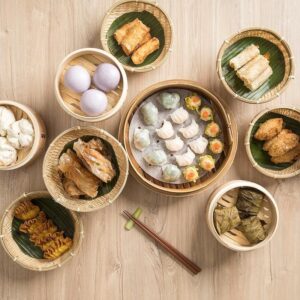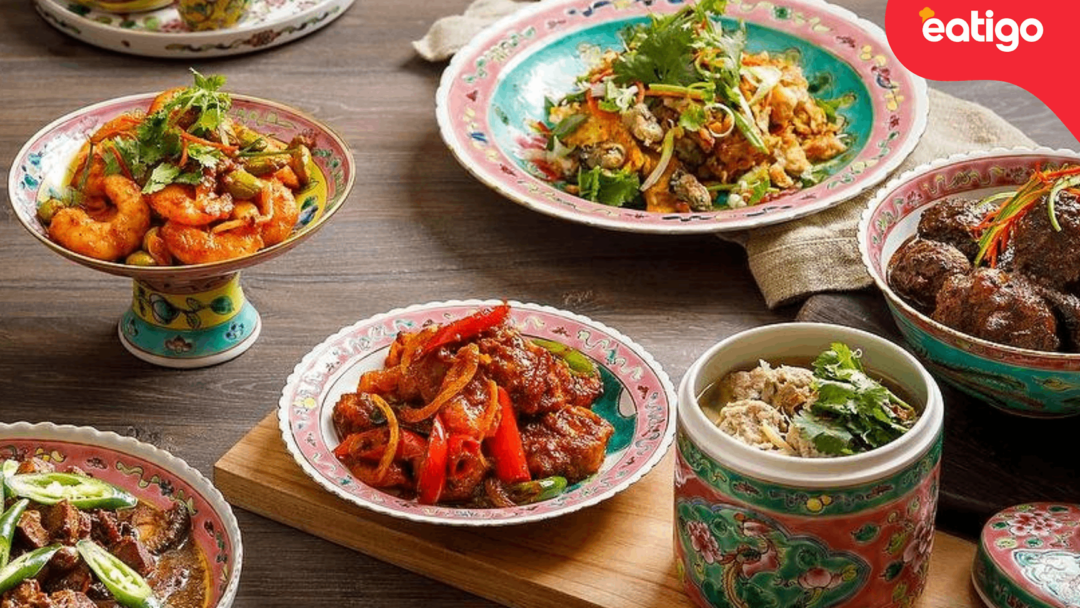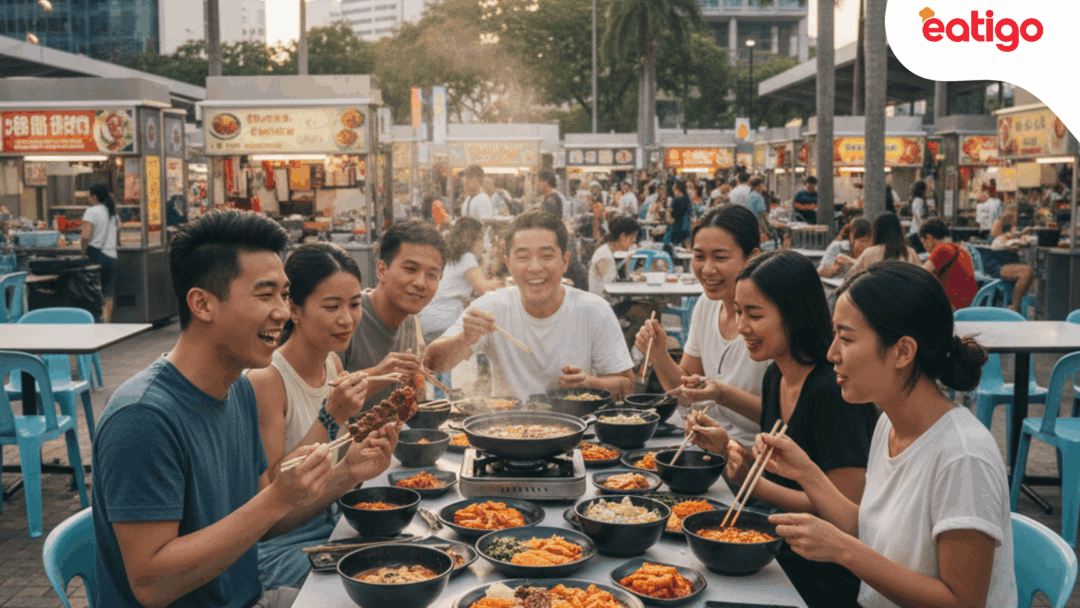
10 best hi tea buffet in Singapore update 2025
December 3, 2024
【EARLYXMAS】🎁 INSTANT $5 OFF 🌟
December 5, 2024Singapore, the ultimate food paradise, continues to tantalize taste buds with its diverse culinary offerings. Our 2025 guide celebrates the top 20 iconic Singaporean dishes you absolutely must try. From hawker center classics to modern gastronomic delights, this list highlights the flavors that define the Lion City.
Best singapore food you must try

1.Hainanese Chicken Rice
Hainanese Chicken Rice is one of Singapore’s most iconic and beloved dishes, often considered the unofficial national dish. It’s a perfect example of simplicity meeting sophistication, with each component carefully prepared to create a harmonious balance of flavors.
Origins:
Hainanese Chicken Rice originates from the Hainan province in China and was brought to Singapore by immigrants. It has since evolved, incorporating local influences to become a staple in Singapore’s hawker centers, restaurants, and even high-end eateries.
Where to try it
- Tian Tian Hainanese Chicken Rice (Maxwell Food Centre)
- Wee Nam Kee Chicken Rice (multiple locations)
- Boon Tong Kee (Balestier and beyond)
2.Chili Crab
Chili Crab is one of Singapore’s most iconic dishes, celebrated for its bold, sweet, savory, and mildly spicy flavors. Often referred to as a must-try when visiting the Lion City, this dish has earned international acclaim for its unique and unforgettable taste.
Origins:
The dish is said to have been invented in the 1950s by Cher Yam Tian, who stir-fried crabs with tomato sauce and chili, creating the first version of Chili Crab. Over the years, chefs refined the recipe into the rich, complex dish we know today.
Where to try it
- Jumbo Seafood (East Coast and Riverside)
- Long Beach Seafood (Dempsey)
- No Signboard Seafood (Geylang)
- Red House Seafood (Clarke Quay)
- Mellben Seafood (Ang Mo Kio)
3.Laksa
Laksa is one of Singapore’s most beloved dishes, blending Chinese and Malay influences into a comforting bowl of noodle soup. It’s a dish that embodies the city’s multicultural heritage, offering a flavorful and satisfying experience for locals and visitors alike.
Origins:
Laksa is believed to have originated from the Peranakan community, a unique blend of Chinese and Malay cultures. Over time, regional variations of Laksa developed, such as Katong Laksa in Singapore, which is known for its thick, creamy broth and short-cut noodles.
Where to try it
- 328 Katong Laksa (East Coast Road)
- Sungei Road Laksa (Jalan Berseh)
- Depot Road Zhen Shan Mei Laksa (Alexandra Village Food Centre)

4.Char Kway Teow
Char Kway Teow is a beloved Singaporean street food dish that has become an iconic part of the city’s culinary identity. Known for its rich, smoky flavors and satisfying mix of textures, this stir-fried noodle dish is a must-try for food lovers exploring Singapore.
Origins:
Char Kway Teow has roots in Chinese Teochew cuisine and was originally a humble dish for laborers due to its affordable and energy-packed ingredients. Over the years, it evolved into one of Singapore’s most popular hawker dishes.
Where to try it
- Outram Park Fried Kway Teow Mee (Hong Lim Food Centre)
- Hill Street Fried Kway Teow (Bedok South Market)
- Lao Fu Zi Fried Kway Teow (Old Airport Road Food Centre)
5.Hokkien Mee
Hokkien Mee is one of Singapore’s most iconic noodle dishes, beloved for its rich flavors and comforting textures. This stir-fried delight is a staple at hawker centers and embodies the vibrant multicultural heritage of the Lion City.
Origins:
Hokkien Mee traces its origins to Chinese immigrants from the Fujian (Hokkien) province in China. Over time, Singaporean hawkers infused local flavors, creating a dish that’s uniquely Singaporean.
Where to try it
- Nam Sing Hokkien Fried Mee (Old Airport Road Food Centre)
- Swee Guan Hokkien Mee (Geylang Lorong 29)
- Ah Hock Fried Hokkien Mee (Chomp Chomp Food Centre)
6.Satay
Satay is one of Singapore’s most iconic dishes, celebrated for its smoky, char-grilled flavors and rich, savory sauces. This Southeast Asian street food is a must-try, offering a delightful mix of marinated meats and vibrant accompaniments.
Origins:
Satay originated in Indonesia and spread across Southeast Asia, where it became a beloved street food in countries like Malaysia, Thailand, and Singapore. The dish has evolved with regional variations, making Singapore’s satay unique with its use of specific marinades and sauces.
Where to try it
- Lau Pa Sat Satay Street (Telok Ayer)
- Chomp Chomp Food Centre (Serangoon Gardens)
- East Coast Lagoon Food Village

7.Nasi Lemak
Nasi Lemak is a beloved dish in Singapore, cherished for its fragrant coconut rice and diverse array of flavorful accompaniments. Originating from Malay cuisine, it has become a staple at hawker centers, casual eateries, and even high-end restaurants across the island.
Origins:
Nasi Lemak originates from Malaysia, but Singapore has embraced and adapted it, creating unique variations while staying true to its traditional essence. It’s a dish that reflects the cultural heritage and shared culinary influences of the region.
Where to try it
- Selera Rasa Nasi Lemak (Adam Road Food Centre)
- Changi Nasi Lemak (Changi Village Food Centre)
- The Coconut Club (Ann Siang Hill)
8.Bak Kut Teh
Bak Kut Teh is a comforting and flavorful dish that holds a special place in Singapore’s culinary heritage. Translating to “meat bone tea,” it features tender pork ribs simmered in a rich broth infused with aromatic herbs and spices, making it a favorite among locals and visitors alike.
Origins:
Bak Kut Teh is said to have originated from Chinese immigrants in Southeast Asia, particularly those in Singapore and Malaysia. It was created as an affordable, nutritious meal for laborers and has since evolved into a beloved dish with regional variations.
Where to try it
- Song Fa Bak Kut Teh (Clarke Quay and multiple locations)
- Founder Bak Kut Teh (Balestier Road)
- Outram Park Ya Hua Rou Gu Cha (PSA Tanjong Pagar Complex)
9.Roti Prata
Roti Prata is one of Singapore’s most beloved comfort foods, enjoyed at any time of day—from breakfast to a late-night supper. This flaky, pan-fried flatbread of Indian origin is a staple in local food culture, cherished for its versatility and satisfying flavors.
Origins:
Roti Prata has its roots in Indian cuisine and was brought to Singapore by South Indian immigrants. Over time, it has been adapted to local tastes, evolving into a uniquely Singaporean favorite.
Where to try it
- The Roti Prata House (Upper Thomson Road)
- Casuarina Curry (Casuarina Road)
- Springleaf Prata Place (multiple locations)
10.Kaya Toast with Soft-Boiled Eggs
Kaya Toast with Soft-Boiled Eggs is a quintessential Singaporean breakfast that offers a perfect blend of sweetness, savoriness, and simplicity. This dish reflects Singapore’s rich coffee shop culture and is a must-try for anyone looking to experience the local food scene.
Origins:
Kaya Toast with Soft-Boiled Eggs is deeply rooted in Hainanese culinary traditions, introduced by early Chinese immigrants. Over time, it became a breakfast staple in Singapore, evolving into a cherished part of the nation’s coffee shop culture.
Where to try it
- Ya Kun Kaya Toast (multiple locations)
- Toast Box (island-wide)
- Killiney Kopitiam (Killiney Road)
11.Mee Rebus
Mee Rebus is a beloved noodle dish in Singapore, celebrated for its rich, flavorful gravy and satisfying combination of textures. This traditional Malay dish is a staple at hawker centers, offering a hearty and comforting meal that reflects the island’s multicultural food heritage.
Origins:
Mee Rebus originates from Malay and Indonesian cuisines, with influences from Chinese cooking techniques. It has become a staple in Singapore’s hawker culture, cherished for its robust flavors and comforting qualities.
Where to try it
- Inspirasi Mee Rebus (Bedok Interchange Hawker Centre)
- Rahim Muslim Food (Tampines)
- Warong Pak Sapari (Adam Road Food Centre)
12.Oyster Omelette (Orh Luak)
Oyster Omelette, known locally as Orh Luak, is a beloved hawker dish in Singapore, celebrated for its crispy, savory textures and fresh seafood flavors. This Teochew delicacy is a popular choice for those seeking a hearty, indulgent treat at hawker centers.
Origins:
Oyster Omelette originated from Teochew cuisine and has become a staple in Southeast Asia. In Singapore, hawkers have refined and adapted the dish to suit local palates, making it a favorite comfort food.
Where to try it
- Simon Road Oyster Omelette (Kovan Food Centre)
- Lim’s Fried Oyster (Bedok 85 Fengshan Food Centre)
- Hup Kee Fried Oyster Omelette (Newton Food Centre)
13.Fish Head Curry
Fish Head Curry is a quintessential Singaporean dish that combines South Indian and Chinese culinary influences into a bold, flavorful experience. Loved for its tangy, spicy, and aromatic curry, this dish is a must-try for anyone seeking a taste of Singapore’s multicultural heritage.
Origins:
Fish Head Curry is believed to have been introduced in the 1940s by an Indian chef in Singapore who wanted to cater to Chinese diners. Over time, it became a signature dish in Singapore’s culinary scene, blending the two cultures seamlessly.
Where to try it
- Muthu’s Curry (Race Course Road)
- The Banana Leaf Apolo (Little India)
- Samy’s Curry (Dempsey Hill)
14.Carrot Cake (Chai Tow Kway)
Carrot Cake, or Chai Tow Kway, is a popular Singaporean hawker dish that’s savory, flavorful, and deeply satisfying. Despite its name, this dish contains no actual carrots—it’s made from radish (daikon) and rice flour, offering a delightful combination of crispy and soft textures.
Origins:
Carrot Cake traces its origins to Chinese Teochew cuisine and was adapted in Singapore to suit local tastes. The name “carrot cake” is derived from the Chinese word for radish, which also translates to “white carrot.”
Where to try it
- Lau Goh Teochew Chye Thow Kway (Zion Riverside Food Centre)
- Famous Bedok Chwee Kueh (Bedok Food Centre)
- He Zhong Carrot Cake (Bukit Timah Market)
15.Hainanese Curry Rice
Hainanese Curry Rice is a beloved Singaporean dish that embodies comfort food at its best. This hearty meal features a generous plate of steamed white rice drenched in rich, flavorful curry and accompanied by an assortment of delicious side dishes. It’s a local favorite for its unpretentious charm and satisfying flavors.
Origins:
Hainanese Curry Rice was created by the Hainanese community in Singapore, blending their culinary traditions with local influences. It’s a reflection of Singapore’s multicultural food heritage, where Chinese cooking techniques meet Southeast Asian flavors.
Where to try it
- Scissors Cut Curry Rice (Jalan Besar)
- Beo Crescent Curry Rice (Tiong Bahru)
- Loo’s Hainanese Curry Rice (Tiong Bahru)

16.Popiah
Popiah is a beloved Singaporean dish that combines fresh, vibrant ingredients wrapped in a thin, soft crepe. This traditional street food is a healthier yet flavorful option, offering a delightful mix of textures and tastes in every bite. It’s a must-try dish for those exploring Singapore’s multicultural food heritage.
Origins:
Popiah originates from the Fujian province in China and was brought to Singapore by early Chinese immigrants. It has since evolved into a local favorite, often served at hawker centers, casual eateries, and even family gatherings.
Where to try it
- My Cosy Corner (Coronation Plaza)
- Kway Guan Huat Joo Chiat Popiah (Joo Chiat Road)
- Ann Chin Popiah (multiple locations)
17.Nasi Biryani
Nasi Biryani is a fragrant and flavorful rice dish that has become a staple of Singaporean cuisine. Originating from Indian and Muslim culinary traditions, this dish is a feast for the senses, combining aromatic spices, tender meat, and perfectly cooked basmati rice.
Origins:
Nasi Biryani traces its roots to Indian and Middle Eastern cuisine, brought to Singapore by Indian and Muslim communities. Over time, it has been adapted to local tastes, becoming a popular dish at hawker centers, Indian-Muslim restaurants, and festive occasions.
Where to try it
- Bismillah Biryani (Dunlop Street, Michelin Bib Gourmand)
- Islamic Restaurant (North Bridge Road)
- Allauddin’s Biryani (Tekka Market)
18.Mee Siam
Mee Siam is a tangy and spicy noodle dish that holds a cherished spot in Singapore’s culinary scene. Its bold, vibrant flavors and unique combination of ingredients make it a must-try for anyone exploring the rich tapestry of Singaporean cuisine.
Origins:
Mee Siam is believed to have Peranakan origins, influenced by Malay, Thai, and Chinese cuisines. Its name, which means “Siamese noodles,” reflects its historical ties to Thailand, though it has evolved into a uniquely Singaporean dish.
Where to try it
- Shi Xian Traditional Mee Siam (Bukit Timah Market & Food Centre)
- The Peranakan (Orchard Road)
- Changi Village Hawker Centre
19.Kway Chap
Kway Chap is a comforting and hearty dish that’s a staple in Singapore’s hawker food culture. Known for its rich soy-based broth and assortment of side dishes, this Teochew-inspired meal offers a flavorful and satisfying dining experience.
Origins:
Kway Chap is rooted in Teochew cuisine and was brought to Singapore by Chinese immigrants. Over time, it has evolved into a local favorite, celebrated for its rich flavors and comforting appeal.
Where to try it
- Garden Street Kway Chap (Serangoon Garden Market)
- Blanco Court Kway Chap (multiple locations)
- Heng Kee Kway Chap (Hong Lim Food Centre)
Madam-Chiang_s-Nutritious-Beauty-Porridge-(Sweet-Porridge)_74c2fb-300x300.jpg)
20.Ice Kachang
Ice Kachang is a colorful and refreshing dessert that’s a quintessential part of Singapore’s hawker food culture. Perfect for cooling off in the tropical heat, this sweet treat combines shaved ice, syrups, and a variety of toppings, making it a feast for both the eyes and the palate.
Origins:
Ice Kachang originated as a simple street food in Southeast Asia, with early versions made using hand-cranked ice machines. Over the years, it has evolved into a vibrant and elaborate dessert, popular in Singapore and neighboring countries.
Where to try it
- Ji De Chi Dessert (Chinatown and multiple locations)
- Mei Heong Yuen Dessert (Chinatown)
- Adam Road Food Centre
Summary
Our 2025 guide showcases the 20 most iconic Singaporean dishes that are a must-try. From beloved hawker center staples to contemporary culinary creations, this list captures the essence of flavors that make the Lion City a food haven.






